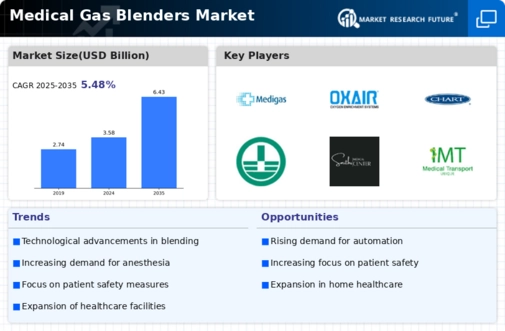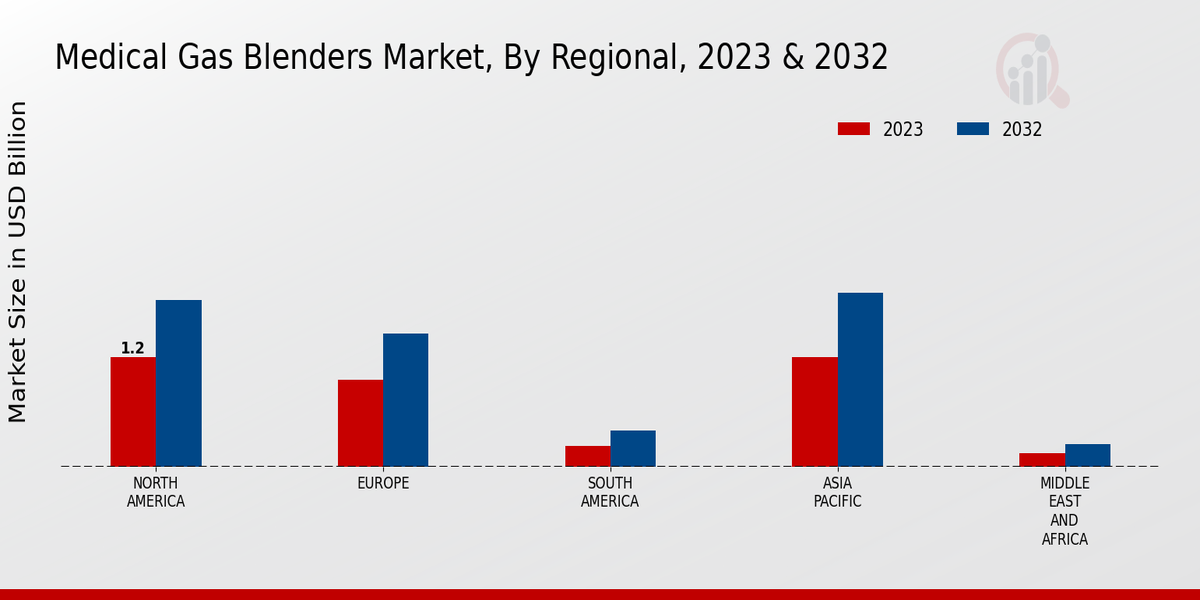Market Growth Projections
The Global Medical Gas Blenders Market Industry is projected to experience robust growth, with estimates indicating a rise from 3.58 USD Billion in 2024 to 6.43 USD Billion by 2035. This growth trajectory reflects a compound annual growth rate of 5.47% from 2025 to 2035, highlighting the increasing adoption of medical gas blending technologies across healthcare facilities. The market dynamics are influenced by various factors, including advancements in technology, rising healthcare expenditures, and the growing emphasis on patient safety. These projections suggest a promising future for the medical gas blending sector, driven by innovation and evolving healthcare needs.
Growing Awareness of Patient Safety
The Global Medical Gas Blenders Market Industry is witnessing a heightened awareness of patient safety, prompting healthcare providers to prioritize the use of reliable gas blending systems. The recognition that accurate gas delivery is critical for patient outcomes drives hospitals to invest in high-quality medical gas blenders. This trend is further supported by initiatives aimed at improving clinical practices and reducing adverse events related to anesthesia and respiratory care. As healthcare organizations strive to enhance patient safety protocols, the demand for advanced gas blending technologies is expected to rise, contributing to the overall growth of the market.
Increasing Demand for Anesthesia Services
The Global Medical Gas Blenders Market Industry experiences a notable surge in demand for anesthesia services, driven by the rising number of surgical procedures worldwide. As healthcare facilities expand their surgical capabilities, the need for precise gas blending becomes paramount. In 2024, the market is projected to reach 3.58 USD Billion, reflecting a growing recognition of the importance of accurate gas delivery systems in enhancing patient safety and outcomes. This trend is expected to continue, with the market anticipated to grow significantly as more hospitals adopt advanced medical gas blending technologies.
Rising Prevalence of Respiratory Disorders
The Global Medical Gas Blenders Market Industry is significantly influenced by the increasing prevalence of respiratory disorders, such as chronic obstructive pulmonary disease and asthma. As the global population ages and environmental factors contribute to respiratory issues, the demand for effective gas blending solutions rises. Medical gas blenders are essential in delivering precise oxygen concentrations for patients requiring respiratory support. This growing need is reflected in the market's projected growth, with estimates indicating a rise to 6.43 USD Billion by 2035. The focus on improving respiratory care is likely to drive further advancements in gas blending technologies.
Technological Advancements in Medical Equipment
Technological innovations play a crucial role in shaping the Global Medical Gas Blenders Market Industry. The introduction of automated gas blending systems enhances accuracy and efficiency, reducing the risk of human error during anesthesia administration. These advancements not only improve patient safety but also streamline operational workflows in healthcare settings. As hospitals increasingly invest in state-of-the-art medical equipment, the market is likely to witness substantial growth. The anticipated compound annual growth rate of 5.47% from 2025 to 2035 underscores the potential for continued innovation and adoption of advanced gas blending technologies.
Regulatory Support for Healthcare Infrastructure
Government initiatives and regulatory support for healthcare infrastructure development are pivotal in shaping the Global Medical Gas Blenders Market Industry. Many countries are investing in modernizing healthcare facilities, which includes upgrading medical gas systems. This regulatory environment fosters the adoption of advanced medical gas blenders, ensuring compliance with safety standards and improving patient care. As healthcare systems evolve, the market is expected to benefit from increased funding and support for innovative medical technologies. The emphasis on enhancing healthcare infrastructure is likely to contribute to sustained growth in the medical gas blending sector.



















Leave a Comment